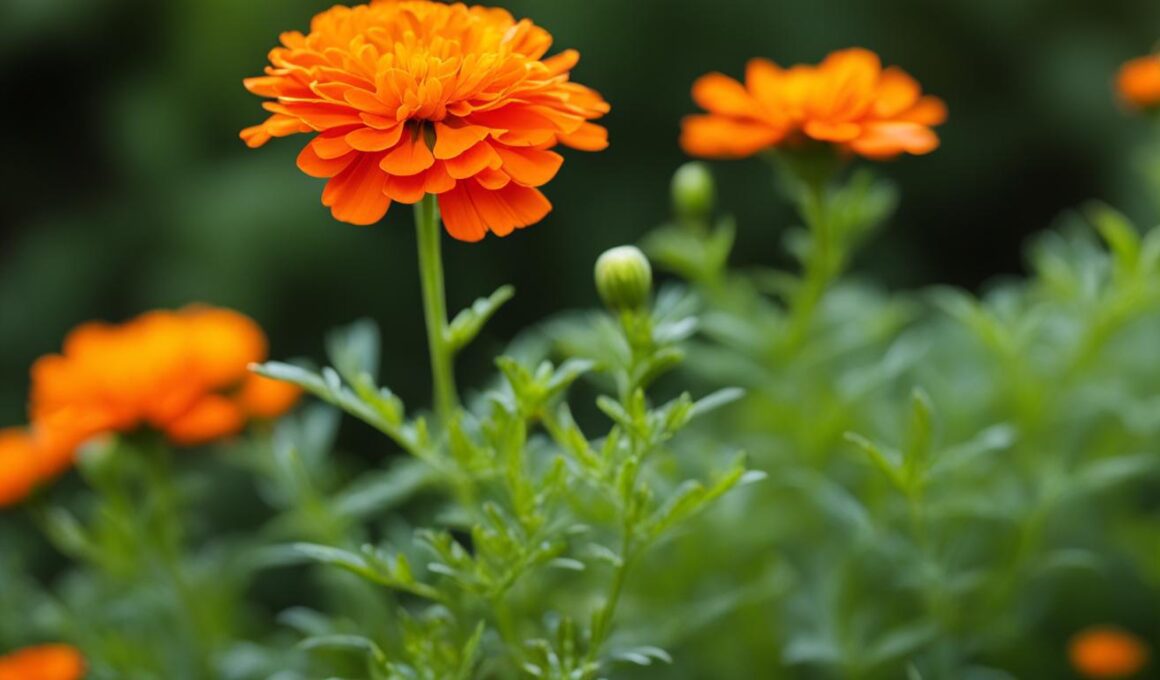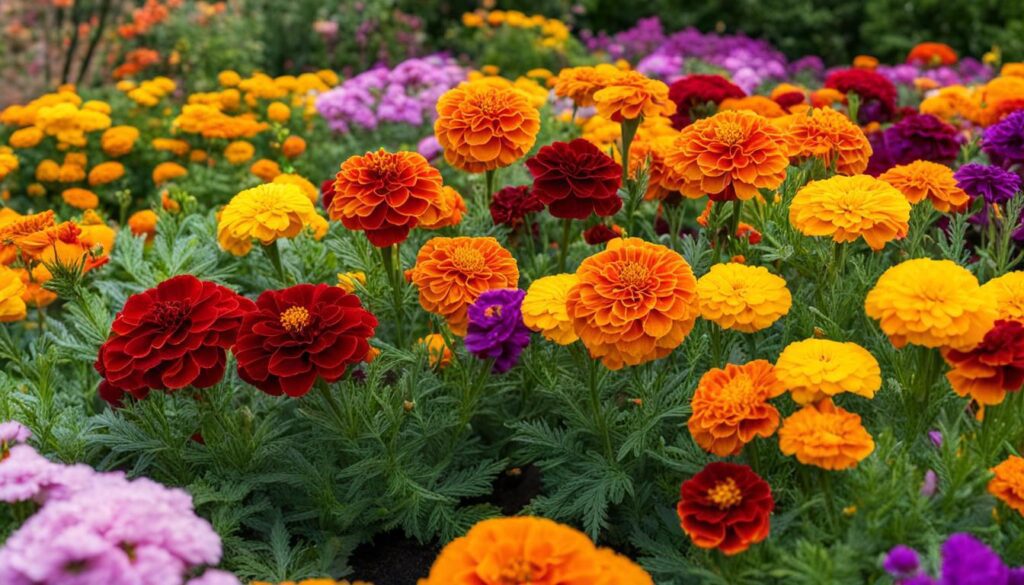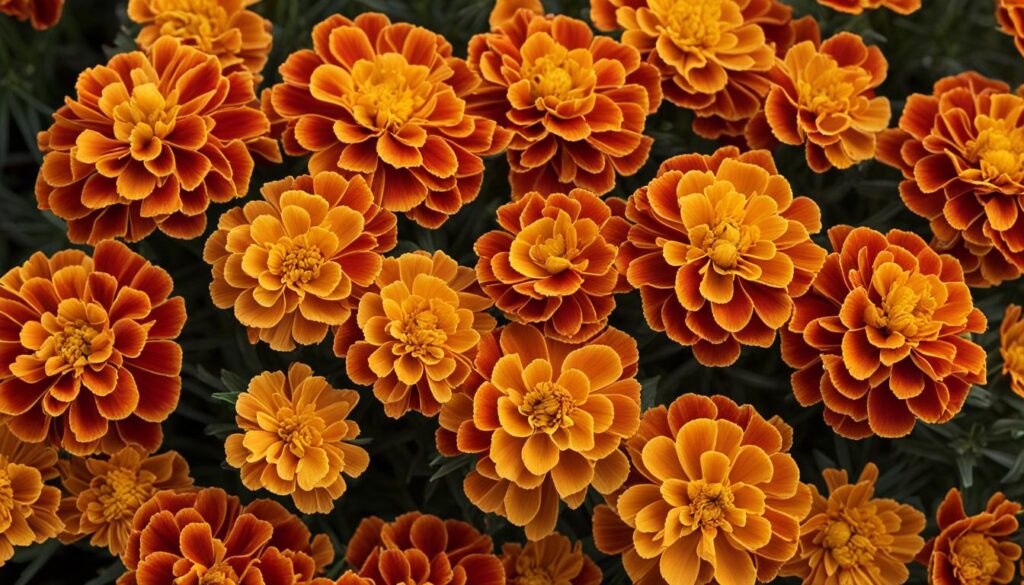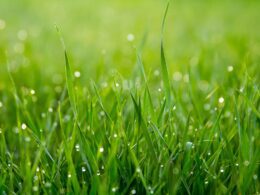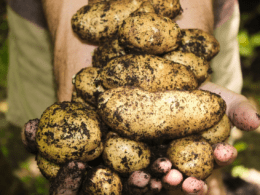Fall is the perfect time to add a burst of color and vibrancy to your garden, and what better way to do it than by growing marigolds? These beautiful flowers come in a wide range of vibrant colors and are incredibly easy to grow. Whether you’re a seasoned gardener or just starting out, marigolds are a fantastic addition to any garden.
Marigolds thrive in full sun and well-drained soil, making them a versatile choice for any garden. Their long blooming season ensures that you’ll have continuous bursts of color throughout the year. Not only do they bring joy and beauty to your outdoor space, but they also attract pollinators like bees and butterflies, creating a vibrant and lively ecosystem.
Marigolds are known not only for their beauty but also for their practical uses. Their edible petals can be used as a colorful garnish for salads or infused into oils and vinegars for a unique flavor. Additionally, their petals can be dried and used in floral arrangements, dyed to create vibrant yellow tones, or even used to make natural teas.
These versatile flowers also serve as effective companion plants and pest control. Marigolds emit a strong scent that naturally repels insect pests, making them an excellent choice for organic pest control. Their roots also produce a substance that repels nematodes, soil-dwelling pests that can harm your plants. By planting marigolds in your garden, you’ll not only enjoy their beauty but also protect your other plants from potential damage.
Key Takeaways:
- Marigolds are easy to grow and thrive in full sun and well-drained soil.
- They attract pollinators like bees and butterflies, creating a vibrant ecosystem in your garden.
- Marigold petals are edible and can be used as a garnish or infused into oils and vinegars.
- They repel insect pests and nematodes, making them an effective companion plant for pest control.
- Marigolds have versatile uses beyond the garden, including natural dyeing and floral arrangements.
Easy to Grow and Versatile
French marigolds are known for their ease of growth, making them a perfect choice for novice gardeners. They can tolerate a wide range of soil types and conditions, as long as they receive plenty of sunlight. Marigolds can be started from seed or purchased as bedding plants. Once established, they self-seed easily, creating a natural display in your garden. They can be planted in various settings, including garden beds, containers, and ornamental borders.
Marigolds are not only beautiful, but they also offer a range of uses and benefits. Their versatility extends beyond the garden, making them a valuable addition to any outdoor space. With their vibrant colors and long-lasting blooms, they are a popular choice for floral displays both indoors and outdoors.
Additionally, marigold petals are edible and can be used in various culinary creations. They can be added to salads, used as decoration for baked goods, or infused into oils and vinegars. Their vibrant color and mild flavor make them a versatile addition to your cooking repertoire. Marigold petals can also be used to dye fabrics naturally, creating vibrant yellow tones. Furthermore, they can be dried and used in potpourri or made into natural soaps and cleaning products. The uses for marigolds go beyond gardening.
Effective Companion Plants and Pest Control
Marigolds are not only beautiful additions to your garden, but they also offer several benefits as companion plants and pest control. When planted alongside other crops, marigolds can help deter pests and promote overall plant health.
The Role of Marigolds as Companion Plants
Marigolds release a chemical from their roots that repels nematodes, a type of soil-dwelling pest that can harm plants. By planting marigolds near susceptible crops, you can reduce the nematode population and protect your plants from damage.
“Marigolds are nature’s pest repellents. Their presence in the garden can help keep unwanted insects away.” – Gardening Expert
In addition to repelling nematodes, marigolds have a strong scent that naturally deters other insect pests. This makes them an excellent choice for organic pest control, as you can reduce the need for harmful chemicals while still protecting your plants.
Attracting Pollinators and Beneficial Insects
While marigolds repel pests, they also attract beneficial insects like bees and butterflies. These pollinators play a crucial role in the reproduction of many plants, including food crops. By incorporating marigolds into your garden, you can create a balanced ecosystem that supports both plant health and biodiversity.
Marigolds are particularly attractive to bees and butterflies due to their bright blooms and nectar-rich flowers. By providing these pollinators with a valuable food source, you can help support their populations and ensure the continued pollination of your garden plants.
| Marigold Varieties | Companion Plants |
|---|---|
| French Marigold | Tomatoes, peppers, basil |
| African Marigold | Cucumbers, squash, melons |
| Signet Marigold | Herbs, strawberries, beans |
As shown in the table above, different marigold varieties can be paired with specific companion plants to maximize their benefits. Consider the needs of your garden and choose the right marigold variety to complement your crops.
By harnessing the power of marigolds as companion plants and pest control, you can create a thriving and balanced garden ecosystem. Enjoy the beauty of these vibrant flowers while reaping the rewards of a pest-free and pollinator-friendly garden.
Edible and Decorative Petals
One of the unique features of marigolds is the edible nature of their petals. These vibrant flowers offer not only visual appeal but also a culinary delight. The petals of marigolds can be used in a variety of ways, adding both flavor and beauty to your dishes. Whether you want to enhance the taste of a salad or create an eye-catching garnish for a dessert, marigold petals are a versatile addition to your kitchen.
The mild flavor of marigold petals makes them suitable for incorporation into various recipes. Their vibrant color adds a pop of visual interest, creating an appetizing presentation. You can sprinkle the petals on top of salads, soups, or even main dishes for an unexpected burst of flavor. Their slightly citrusy and peppery notes complement a wide range of ingredients, making them a versatile ingredient in your culinary repertoire.
Not only are marigold petals edible, but they are also decorative. Their bold shades of yellow, orange, and red can add a touch of vibrancy to any dish. Whether you’re decorating a cake, cupcakes, or cocktails, marigold petals provide a natural and visually pleasing element. The petals can be used whole or torn into smaller pieces depending on the desired effect.
Table: Edible and Decorative Uses of Marigold Petals
| Edible Uses | Decorative Uses |
|---|---|
| Add to salads, soups, and main dishes | Use as a garnish for cakes, cupcakes, and cocktails |
| Infuse into oils and vinegars for added flavor | Create vibrant floral arrangements |
| Dry and use in teas for a unique twist | Make natural dyes for fabrics |
With their versatility and visual appeal, marigold petals are a must-have ingredient in any kitchen. Not only do they add a pop of color to your dishes, but they also offer a mild and unique flavor. Experiment with different recipes and techniques to unlock the full potential of marigold petals in your culinary creations.
Benefits for Pollinators and Pest Control
Marigolds offer numerous benefits for pollinators and natural pest control in your garden. By incorporating these vibrant flowers into your outdoor space, you can create a thriving ecosystem that supports both beneficial insects and the pollination process.
Attracting Pollinators
Marigolds serve as a valuable food source for bees, butterflies, and other pollinators throughout the growing season. The bright blooms of these flowers act as beacons, attracting various species of pollinating insects and increasing the diversity of your garden ecosystem. By providing a reliable nectar source, marigolds contribute to the health and abundance of pollinators in your area.
Repelling Pests
In addition to attracting pollinators, marigolds also help repel common garden pests. The strong scent produced by these flowers naturally deters insect pests such as aphids, whiteflies, and mosquitoes. By planting marigolds near your vegetable or fruit crops, you can reduce the likelihood of pest infestations and the need for chemical pesticides. Marigolds act as a natural form of pest control, making them a valuable asset in your garden.
With their dual role as pollinator attractants and pest repellents, marigolds contribute to the overall health and balance of your garden. They create a harmonious environment where beneficial insects thrive, controlling pests naturally and ensuring successful pollination for your plants.
| Pollinator Benefits | Pest Control Benefits |
|---|---|
|
|
“Marigolds are nature’s way of attracting pollinators and repelling pests. By incorporating these vibrant flowers into your garden, you create a balanced ecosystem that supports the health and productivity of your plants.”
Additional Uses and Benefits
Marigolds have a wide range of additional uses and benefits beyond their role in gardening. Their vibrant petals can be utilized for natural dyeing, creating beautiful yellow tones for fabrics. The process involves simmering the petals in water to extract the color, which can then be used to dye various materials. This eco-friendly method of dyeing adds a touch of nature’s vibrance to your clothing or home decor.
Petals for Natural Dyeing
Marigolds also offer the opportunity to extract their essential oil, which can be used in perfumery and blended with other oils. The oil is derived from the entire plant and carries the distinct aroma of marigolds. Whether used for DIY perfumes or incorporated into skincare products, marigold essential oil adds a natural touch and a hint of floral fragrance.
In addition to their culinary and aromatic uses, marigolds can be dried and used in various crafts. The dried petals can be added to potpourri blends, filling your home with their pleasant scent. They can also be incorporated into homemade soaps and cleaning products, providing a natural and colorful touch to your daily routines.
| Additional Uses | Benefits |
|---|---|
| Natural dyeing | Adds vibrant yellow tones to fabrics |
| Essential oil extraction | Used in perfumery and skincare |
| Dried petals | Incorporated into potpourri, soaps, and cleaning products |
Table: Additional Uses and Benefits of Marigolds
Marigolds offer not only beauty in the garden but also a multitude of uses beyond their vibrant blooms. From natural dyeing to essential oil extraction, these versatile flowers can add color, fragrance, and a touch of nature to your everyday life.
Marigolds truly deserve a place in every garden, not only for their vibrant colors and ease of growth but also for their numerous benefits and versatile uses. Whether you’re looking to add a pop of color to your outdoor spaces, attract pollinators, repel pests, or explore their culinary and craft possibilities, marigolds are an excellent choice. Embrace the vibrancy and versatility of marigolds and unlock their full potential in your garden and beyond.
How Can Growing Marigolds in a Vegetable Garden Boost Harvest?
Growing marigolds in a vegetable garden can boost your harvest in numerous ways. Marigolds help to repel harmful nematodes and attract beneficial insects, making them a great companion plant for vegetables. Their strong scent can also deter pests, while their vibrant flowers beautify the garden and provide nectar for pollinators.
Conclusion
Marigolds are a fantastic choice for adding vibrance and beauty to your garden. With their ease of growth, versatility, and benefits as companion plants and pest control, they offer a multitude of advantages.
From their edible and decorative petals to their ability to attract pollinators and repel pests, marigolds are a valuable addition to any garden. Whether you choose to grow them from seed, purchase bedding plants, or let them self-seed, marigolds will bring joy and color to your outdoor spaces.
Embrace the vibrancy of marigolds and create a colorful oasis in your garden.
FAQ
Are French marigolds easy to grow?
Yes, French marigolds are known for their ease of growth, making them a perfect choice for novice gardeners.
What kind of soil do French marigolds need?
French marigolds can tolerate a wide range of soil types and conditions, as long as they are well-drained.
Can French marigolds be grown in containers?
Yes, French marigolds can be grown in containers, garden beds, and ornamental borders.
Do French marigolds attract pollinators?
Yes, French marigolds attract pollinators like bees and butterflies, helping to increase the diversity in your garden.
Are marigold petals edible?
Yes, marigold petals are edible and can be used to garnish salads, decorate baked goods, or infused into oils and vinegars.
Can marigold petals be used for natural dyeing?
Yes, marigold petals can be used to naturally dye fabrics, creating beautiful yellow tones.
Do marigolds repel pests?
Yes, marigolds have a strong scent that naturally repels insect pests, making them an excellent choice for pest control without harmful chemicals.
Are marigolds beneficial companion plants?
Yes, marigolds are beneficial companion plants as they repel nematodes and attract beneficial insects that prey on pests.
Can marigold petals be used for other purposes?
Yes, marigold petals can be dried and used in floral arrangements, natural teas, potpourri, soaps, and cleaning products.





